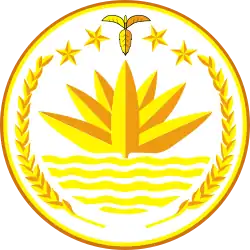Jumma people
The Jumma people (Bengali: জুম্ম জনগোষ্ঠী) is a term usually referred to the minority tribal group of people of the Chittagong Hill Tracts region of Bangladesh who claim a separate state called Jumma Land. They include the Chakma, Arakanese (Rakhine), Marma, Tripuri, Tanchangya, Chak, Pankho, Mru, Bawm, Lushai, Khyang, and Khumi.[1][2]

The name jumma ("jum farmer") is derived from jum cultivation, or slash-and-burn rain forest & razed hill farming .[3] They are also known as Pahari, which simply means "hill people".[4]
The Jumma people are native speakers of Tibeto-Burman languages, unrelated to Bangla spoken by ethnic Bengalis. Religiously they are distinct as well, most being Buddhist, some Hindu and some are converted Christian & Muslim. In addition, they have retained some traditional religious practices.[5]
Pakistan Period
During construction of Kaptai Dam more that 18,000 families and 100,000 tribal people were evicted by president of Pakistan Ayub Khan without appropriate resettlement facilities & compensation.[6] More than 40,000 Chakma tribals emigrated to Arunachal Pradesh,[7] India.[8] From that time Jumma people started grudge the government for their distress.[9]
During independence of Bangladesh
In 1971, most of the Jumma tribes were neutral or supporting Liberation War of Bangladesh. Except majority of the Chakma people was against the independence of Bangladesh under leadership of Chakma circle chief Raja Tridev Roy.
Bangladesh Period
Between 1978 and 1990, ruling military junta government started considering Jumma people including Chakmas as traitor & potential risk for independent Bangladesh. Allegedly 400,000 Bengali homeless people were relocated in the Chittagong Hill Tracts with home, arable land and food rationing.[10] It causes tension between Bengali & tribal groups. Between 1979 and 1997, over 15 major conflict took place between Bengali Muslim and minority tribes where government agencies have allegation to support Bengali people.[10] Due to the outbreaks of violence, communal and social unrest, many fled to the Indian states of Mizoram and Tripura, or to Burma .[10]
Peace negotiations were initiated by democratic government in 1996 by prime minister Sheikh Hasina of the Awami League, the daughter of Sheikh Mujib. The peace accord was finalized and formally signed on 2 December 1997.[11]
References
- পার্বত্য চট্টগ্রামে মাথাচাড়া দিয়ে উঠছে ‘স্বাধীন জুম্মল্যান্ড’ সংগ্রাম | সারাদেশ | The Daily Ittefaq. The Daily Ittefaq. 8 November 2018. Retrieved 14 October 2020.
- Van Schendel, Willem (2001). Willem van Schendel, Erik J. Zurcher (ed.). Identity Politics in Central Asia and the Muslim World. I.B.Tauris. p. 141. ISBN 978-1-86064-261-6.
- Roy, Rajkumari Chandra Kalindi (2000). Land Rights of the Indigenous Peoples of the Chittagong Hill Tracts. IWGIA. p. 28. ISBN 978-87-90730-29-1.
- International Labour Office (2000). Traditional occupations of indigenous and tribal peoples: Emerging trends. International Labour Organization. p. 78. ISBN 978-92-2-112258-6.
- Samaddar, Ranabir (2003-07-04). Refugees and the State: Practices of Asylum and Care in India. SAGE Publications. p. 251. ISBN 978-81-321-0377-6.
- "The construction of the Kaptai dam uproots the indigenous population (1957–1963)". Internal Displacement Monitoring Centre. Archived from the original on 27 September 2007. Retrieved 1 February 2007.
- Chakravarty, Ipsita. "50 years on, Chakma refugees from Bangladesh are still denied citizenship rights in Arunachal". Scroll.in. Retrieved 27 January 2019.
- "How Chakmas and Hajongs settled in North East, why Arunachal worries about citizenship". The Indian Express. 20 September 2017.
- "The construction of the Kaptai dam uproots the indigenous population (1957–1963)". Internal Displacement Monitoring Centre. Archived from the original on 27 September 2007. Retrieved 1 February 2007.
- I, Fonkem Achankeng (2015-09-28). Nationalism and Intra-State Conflicts in the Postcolonial World. Lexington Books. ISBN 978-1-4985-0026-5.
- Majumder, Shantanu (2012). "Parbatya Chattagram Jana-Samhati Samiti". In Islam, Sirajul; Jamal, Ahmed A. (eds.). Banglapedia: National Encyclopedia of Bangladesh (Second ed.). Asiatic Society of Bangladesh.
